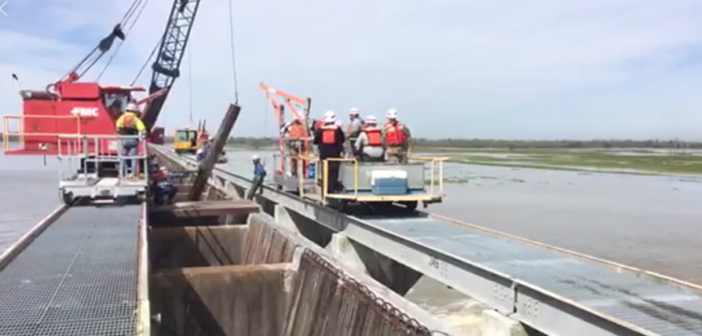While all eyes were on the coronavirus pandemic, high water on the inland waterway system was making its presence known once again early this year. High water conditions on the system in 2019 created a host of problems for inland waterways operators, as portions of the Mississippi River were closed periodically throughout the year.
This year did not start off well either. The Army Corps of Engineer’s Mississippi Valley Division (MVN) had to open the Bonnet Carré Spillway near Baton Rouge, La., on April 2.
The Corps opened an additional 20 bays of the Spillway on April 9 to ensure the maximum flow at New Orleans did not exceed the target flow of 1.25 million cubic feet per second (cfs). The Spillway’s operation is based on the estimated flow at Red River Landing (Mile 302.4 on the Mississippi) where the flow April 9 was reported to be 1.31 million cfs.
“The Bonnet Carre´ Spillway was opened this year to manage the flow of the Mississippi River around New Orleans during the high river event,” said Matt Roe, public affairs specialist, U.S. Army Corps of Engineers, New Orleans District. “The Spillway was open for 29 days from April 3 to May 1 with a maximum of 90 bays open and a peak discharge of 90,000 cubic feet per second.”
The Bonnet Carre´ Spillway is a flood control structure on the Mississippi extending from Mile 128.8 Above Head of Passes to Mile 127.3 Above Head of Passes. It is designed to pass flood water from the Mississippi River into Lake Pontchartrain above New Orleans to prevent flooding below the Spillway.
While the number of days the Spillway bays were up in 2020 were fewer than the record-setting pace reached in 2019, high water on the entire inland waterway system lasted much longer than the 29 days that the Bonnet Carre´ was opened.
“The high-water season on the Mississippi River this year lasted 176 days from Jan. 9 to June 30 with the river being above 15 feet at the Carrollton Gage (in New Orleans) for 93 days,” said Roe. “Currently the river is about 5 feet on the Carrollton Gage, below the flood fight trigger of 11 feet.”
The historic and unprecedented high-water event surpassed the 1973 high water event, 225 days, as the longest in the New Orleans District’s history.
While numbers indicate that water levels upriver are not at flood stage as of mid-November, that was not the case back in May. On the Great Lakes, the start of the shipping season was delayed 12 days due to high-water levels on Lake Ontario.
“Once it was deemed safe for shipments to begin, the pandemic hit, fluctuating typical cargo needs,” Bruce Burrows, president and CEO of the Chamber of Marine Commerce, said back in May. “There has been strong demand for American wheat for worldwide bread and pasta production, but iron ore shipments slowed down in April as domestic steel production for the automotive sector declined during factory shutdowns. In our industry, it can take months before the full impacts of an economic downturn take effect, so we will be watching closely as the situation evolves over the coming weeks.”
The high-water levels in Lake Michigan were felt at Port Milwaukee, as sporadic flooding and dock damage occurred.
“Our tenants and staff are working to offer our customers safe, efficient and ongoing access to world markets despite pandemic conditions and the delayed opening of the St. Lawrence Seaway,” said director Adam Schlicht. “At many ports, including Milwaukee, historically high-water levels have caused sporadic flooding and dock damage, which will continue without new infrastructure improvements.”
Throughout all high-water challenges, the Corps of Engineers works closely with federal, state, and local partners to coordinate efforts and conduct inspections of the entire river levee system to ensure it would perform as designed and safely pass the high water.



.JPG.small.400x400.jpg)

